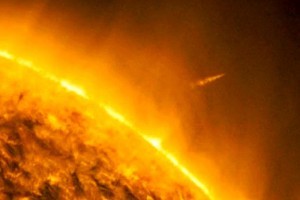An elongated coronal hole stretching across the face of the sun sent solar wind particles gushing toward Earth last week.
NASA’s Solar Dynamics Observatory has revealed a stunning animation of the phenomenon, showing the massive dark patch marring the surface of our star.
Space-weather forecasters warned that the resulting geomagnetic storm, while minor, could have some effects on satellites and the power grid.
And, the activity brought breathtaking auroras dancing across the sky in the higher latitudes.
The image shows a coronal hole that opened between January 2 and 5.
These are areas in which the magnetic field has opened, allowing solar wind particles to come streaming out.
‘In this wavelength of extreme ultraviolet light it appears as a dark area near the center and lower portion of the sun,’ NASA explains.
The particle stream during this period brought a greater chance of seeing the Aurora Borealis in Canada, northern US, Scandinavia, Scotland and even England.
Space-weather forecasters issued a ‘G2 alert’, the second lowest classification on the geomagnetic storm scale.
‘The principal users affected by geomagnetic storms are the electrical power grid, spacecraft operations, users of radio signals that reflect off of or pass through the ionosphere, and observers of the aurora,’ the NOAA said.
But, at such a low classification, the effects of the solar storms on power grids and spacecraft operation are typically expected to be minor.
This past fall, solar winds triggered a giant geomagnetic storm, raising fears that they could cripple power supplies.
The charged particles came from a coronal hole on the sun while it was facing Earth.
Warnings were issued by the operator of the biggest power grid in the US, PJM Interconnection LLC, as well as by Midcontinent Independent System Operator, which manages high-voltage power lines across North America, reports Bloomberg.
These were the result of US Space Weather Prediction Center raising a ‘serious’ G3 level storm alert, though the alert was later downgraded to a less severe G2 storm.
‘Voltage corrections may be required, false alarms triggered on some protection devices’, said the U.S. Space Weather Prediction Center.
‘Drag may increase on low-Earth-orbit satellites, and corrections may be needed for orientation problems’.
The ‘moderate’ G2 warning remained in effect for some time afterward.
The solar storms could potentially affect telecommunications and power infrastructures all over the globe.
The UK’s Met Office space weather forecast for said: ‘Elevated solar winds are expected throughout the period, with G1-G2 minor to moderate geomagnetic storms forecast.’
As a result of the solar storm currently blasting Earth, parts of the world lit up with a green and pink glow tonight.
Ask me anything
Explore related questions







